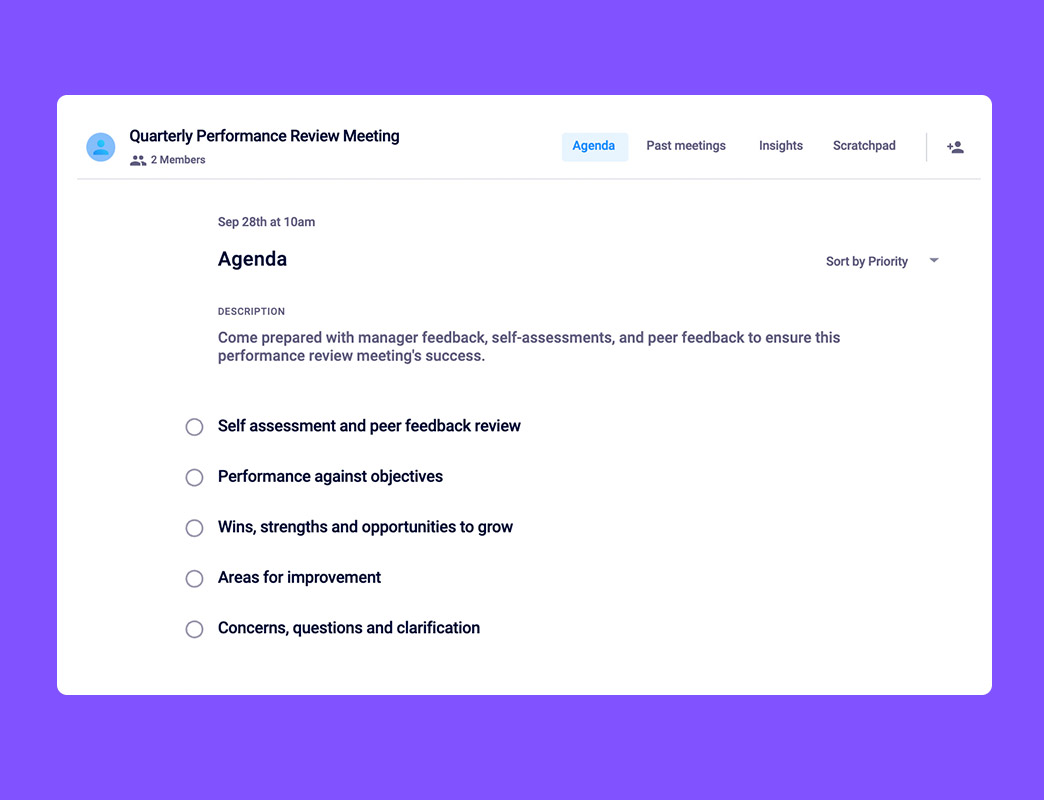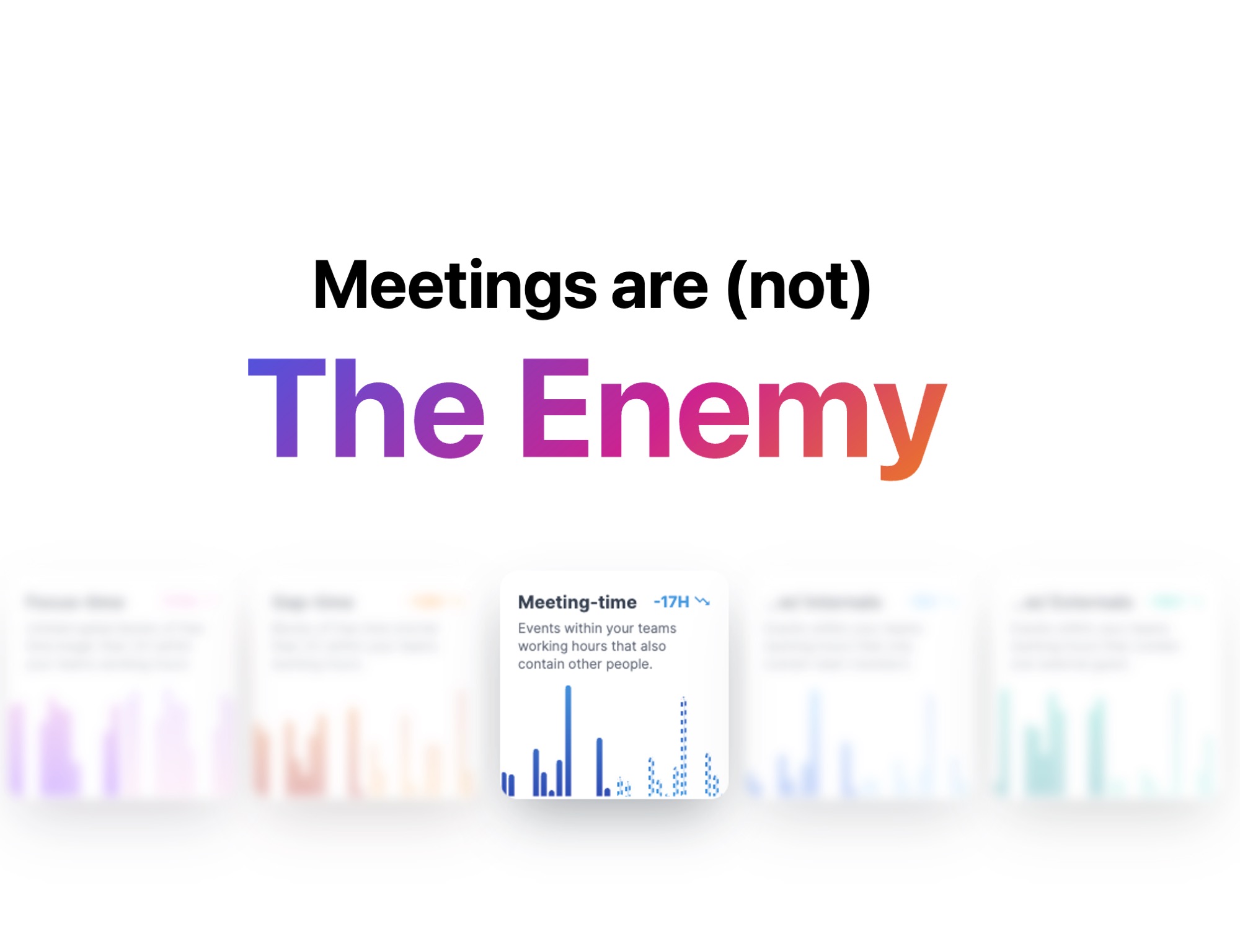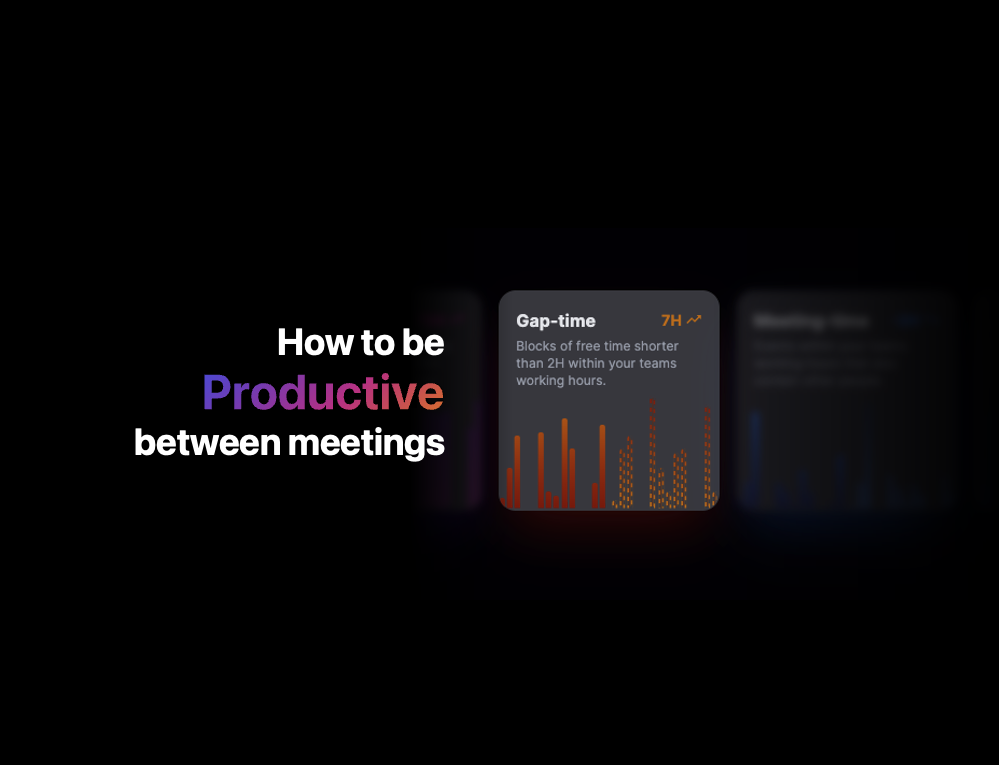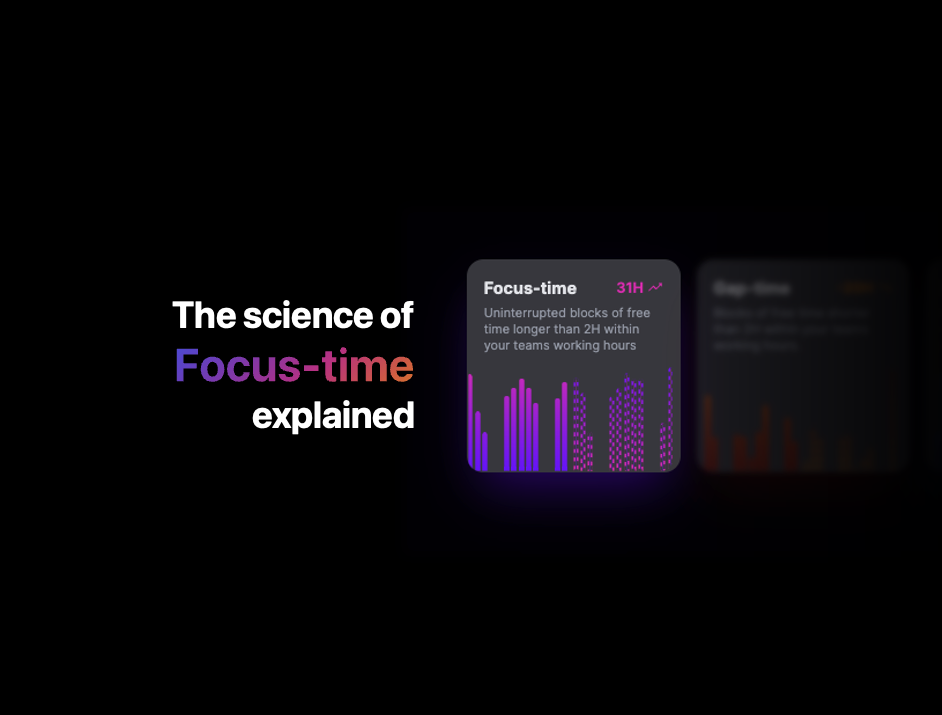How to run a quarterly performance review (plus a template)
8 min readQuarterly performance reviews are the best way to provide feedback, celebrate achievements, and set actionable goals with your direct reports.

Quarterly performance reviews are the best time to reflect on your employee’s performance, celebrate wins, and give constructive feedback. Providing your team with effective quarterly performance reviews is the key to a successful and collaborative team and company.
If you’ve struggled to run quarterly performance reviews in the past effectively, we’re excited to share our easy-to-use quarterly performance review template with you. It will help you get the most out of your meeting, facilitating a collaborative experience with your direct reports.
Read on to learn how to make the most of quarterly performance reviews and grab the template below:
What’s the purpose of a quarterly performance review?
What roles does an employee play in a quarterly performance review?
How do you conduct a quarterly performance review?
5 items to add to your quarterly performance agenda
Quarterly performance review agenda template
What’s the purpose of a quarterly performance review?
Also known as “performance snapshots,” since they tend to highlight short-term goals, quarterly reviews let managers address performance issues quickly. Well, more quickly than an annual review.
They make space for both the employee and manager to collaborate on a plan that helps the employee grow, providing space to check in on a regular basis, and ensuring that performance is trending upwards. Quarterly reviews are opportunities to reward good behaviors and practices and address challenges.
This is also a great time to reinforce the connection between individual performance, team goals and company vision. Start setting quarterly goals if you haven’t already, and tie them back to the company’s goals. By finishing off the quarterly review cycle with a collaborative review meeting that aligns with each new set of goals, you’ll be equipped with an impactful way to review performance against those goals — making it a more objective process.
This not only allows employees to feel part of the team, and to take ownership of their role, it’s a chance for you, as a manager, to be a supportive force in their growth.
What role does an employee play in a quarterly performance review?
Above all, the primary function of a quarterly review is to support your direct report’s growth. But to do this effectively, managers must be mindful about how they evaluate their employee’s progress. By taking stock of the last quarter and reviewing it in-depth, they can smartly identify what went well, where, if any, the gaps were and how you and your employee can improve next quarter.
Between the employee and employer, each has their own role to play in the quarterly performance review process. From the get-go, we encourage managers to avoid thinking of the review as a top-down process. Include your direct report and come ready for a conversation. It’s helpful to have an agenda in place beforehand to which both parties can contribute.
By including your employee in the process, you’ll also empower them to review themself. Encourage them to reflect on:
- How they think the quarter went.
- Where they think they can improve.
- Some big, audacious goals they would like to set for the future.
- More attainable, short-term goals for next quarter (Psst: try the OKR framework)
- Check out our list of 121 one-on-one questions to inspire more reflection points
The benefit of asking your employee to perform a self-assessment is that you gain insight into their thoughts around their roles, goals, desired trajectory, and aspects of their job or environment that they may be struggling with. In an ideal world, there will be an overlap between their self-assessment and your assessment of them in terms of strengths and challenges.
How do you conduct a quarterly performance review?
When handled poorly, quarterly reviews can have significant negative impacts on morale. Handled correctly, they can be the positive lift your team needs to be their best. Effective quarterly reviews are a surefire way to retain your employees by showing you’re invested in their progress. But remember, to get the most out of them, they require preparation.
Here are a few tips on how to conduct a quarterly performance review as a manager.
Work in advance.
Give yourself enough lead time to prepare your feedback — both positive and constructive. Put the quarterly performance review meeting in the calendar well in advance and have a touchpoint a few weeks before the meeting. Share thoughts and an agenda ahead of time.
Where possible, ensure human communication. In the age of remote work and hybrid workplaces, providing person-to-person, synchronous communication can alleviate the stress of high-anxiety situations like a quarterly performance review.
Provide specific and constructive feedback.
Giving constructive feedback is an art and is essential to the success of both your team and organization. Yet, many of us are unable to provide it effectively. By making sure that your feedback is specific and actionable, your direct report won’t be left guessing or uncertain how to move forward.
While a quarterly performance review is an ideal time to share feedback, we encourage you to avoid waiting to share feedback with your team members. Nobody likes being caught off guard, especially in a quarterly performance review, which can be an anxiety-causing situation. Managers should be mindful of their employees and work to avoid blindsiding them with surprise feedback. You can sidestep this by creating a continuous feedback loop on your team. This begins well before the quarterly performance review process.
Include other team member’s feedback in the process.
Traditionally, feedback has been shared top-down, from managers to direct reports. A 360-degree review can encourage employee feedback from all directions: Top-down, upwards, peer-to-peer, etc.
Professor of Management at Yale John Barron shares in his article that “The larger number of independent evaluations the better.”
We agree.
When giving your direct report a review, including team member feedback is crucial.
By evaluating the ways your employee’s work and interactions have impacted their colleagues, along with the skills and contributions they’ve brought to the table, your employee can get a sense of their overall impact from a broader range of inputs.
Take notes and assign next steps to ensure follow-through.
Don’t forget, any employee performance review isn’t effective without agreed-upon next steps. Before the end of the meeting, make sure you have agreed-upon next steps and a collaborative action plan in place.
Our tip? Reserve 10-15 minutes at the end of the meeting and collaborate on a list of around 3-4 points achieved during the next quarter to drive future success.
5 items to add to your quarterly performance review agenda
1. Self-assessment and peer feedback
Come prepared with 360-degree feedback from your employee’s peers and ask them to prepare a self-assessment beforehand.
Why start with this? It opens up the meeting to be a conversation, rather than a top-down “presentation”. Instead of starting off with the manager’s assessment, open the floor to your team member to let you know how they think they’re doing and to discuss feedback from their colleagues — junior, lateral and senior alike.
2. Performance against objectives
Ladder up performance to objectives. This allows your employee to see themselves as part of something bigger and empowers them to understand their role in the company.
It also makes feedback more objective. When you’re looking at performance based on goals, rather than performance based on opinion, it becomes less personal and easier to digest constructive feedback.
3. Wins, strengths, and growth opportunities
Positive feedback is equally as important as constructive feedback. Everybody likes to be recognized! Finding ways to show your employee that they’re appreciated and highlighting achievements can reinforce their experience. It can encourage repeat performance in critical areas.
Don’t only talk about the past — look forward to the future too and discuss career growth opportunities and goals based on strengths.
4. Areas of improvement
Giving feedback around areas that the employee can improve for the next quarter is vital to their employee experience. Don’t shy away from providing difficult feedback — this won’t only help the team grow, it’ll also help them develop personally.
Have to provide some tough-to-deliver feedback? Try out our CEO, Brennan’s “Lettuce Pact” approach or LeeAnne Renninger’s 4-part feedback framework. Or both!
5. Concerns, questions, clarification
To maintain a balanced, collaborative interaction, set aside time during the meeting for your direct reports to share their thoughts and questions with you. It’s also an opportunity for them to provide peer and upward feedback and ask for further clarity on any questions or feedback you provide. You don’t want anyone to leave their quarterly performance review confused.
If they don’t have any questions at the end, try prompting them by asking:
- What are you least clear about?
- What’s your outlook on the next quarter?
- How are you feeling?
- Are you surprised by any of the feedback?
- Do you feel supported?
Hypercontext’s quarterly performance review agenda template
Providing a successful quarterly performance review doesn’t have to be challenging. By encouraging rather than judging and supporting your employees through the process, you can help your team — and your company— flourish. Check out our quarterly review meeting agenda to get started. 👇



